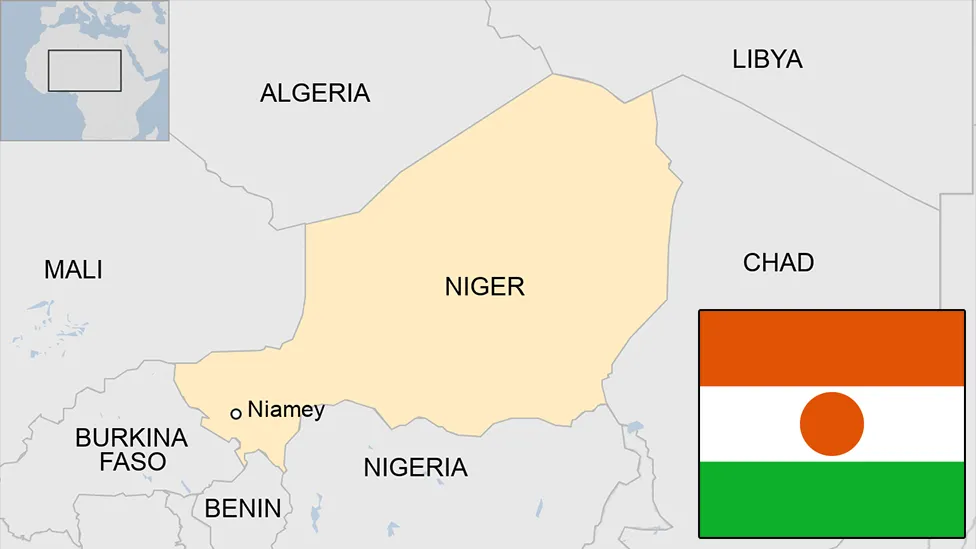A vast, arid state on the edge of the Sahara desert, Niger has seen a series of coups and political instability in the decades following independence from France in 1960.
Today the country struggles with frequent droughts and poverty. Niger is betting on increased oil exploration and gold mining to help modernise its economy. It is a significant producer of uranium.
Mohamed Bazoum became president in April 2021 in Niger’s first democratic transfer of power since independence in 1960, but was deposed in an army-led coup in July 2023.
Western nations had looked to Niger as a bulwark against further disorder and spreading Russian influence in the region. It hosts French and US military bases and before the coup was seen as a key partner in the fight against the Islamist insurgencies in the region.
The new junta has said it is ending all military cooperation agreements with France and that agreements on the presence of French troops would be cancelled.
REPUBLIC OF THE NIGER: FACTS
Capital: Niamey
Area: 1,267,000 sq km
Population: 24.4 million
Languages: French, Arabic, Buduma, Fulfulde, Gourmanché, Hausa, Kanuri, Zarma, Songhai, Tamasheq, Tassawaq, Teb
Life expectancy: 60 years (men) 62 years (women)LEADER
President: Mohamed Bazoum (deposed)
The leader of the presidential guard that removed President Bazoum is Gen Abdourahmane Tchiani, also known as Omar Tchiani.
Gen Tchiani has been in charge of the presidential guard since 2011. He was promoted to the rank of general in 2018 by former president Issoufou.
However, he has frequently been mentioned in the media in Niger over the years for his alleged role in a 2015 coup attempt and the subsequent court case in 2018 that cleared him of involvement.
Tchiani said the army overthrew Bazoum because of “deteriorating bad governance” in the country and dissatisfaction with his handling of security matters.
The July 2023 military coup has plunged the Sahel into further uncertainty after similar takeovers in neighbouring Burkina Faso and Mali.
An insurgency that broke out in northern Mali in 2012 has worsened over the years, spreading violence to Burkina Faso, Niger and, in recent years, countries close to the Gulf of Guinea.
Mali’s decision to deploy Russia’s Wagner Group mercenaries triggered France’s troop and diplomatic withdrawal from the country, and the winding down of operations of the 13,000-strong UN peacekeeping mission, Minusma.
Bazoum had welcomed those forces to Niamey as part of a renewed strategy to buffer Niger and other West African states from the destabilising effects of violence by Islamic State and al-Qaeda militants.
His removal by Gen Tchiani threatens to scuttle these partnerships.
MEDIA
Niger’s underdeveloped media sector reflects the country’s poverty and low levels of literacy, which constrain media development and limit public access to some platforms and outlets.
The threat from jihadists is a further challenge to the media sector and those who work in it.
Radio is a key news source and local privately-owned stations operate alongside the national state broadcaster.
Some key events in Niger’s history:
5th Century BC – region becomes an area of trans-Saharan trade. Led by Tuareg tribes from the north.
c. 300AD-1200s – Much of the region is part of the Ghana Empire, one of several major West African empires controlling trans-Saharan trade in gold, salt, other precious commodities – and slaves.
c. 632-700s – Arab invasion of North Africa and subsequent spread of Islam.
c.1226-1670 – Mali Empire becomes dominant force in the upper Niger basin following the Battle of Krina in 1234.
c. 1464-1591 – as the Mali Empire loses some of its power, losing its dominance of the gold trade, the Songhai Empire gradually gains control over the eastern half of the Mali Empire.
1591 – The Battle of Tondibi. Songhai forces decisively defeated by the army of the Saadi dynasty in Morocco, who make Timbuktu their capital.
The fall of the Songhai Empire marks the end of the region’s role as a trading crossroads. Area splinters into smaller kingdoms including the Kanem-Bornu Empire around Lake Chad, the Sultanate of Aïr in the north, and Hausa kingdoms and others.
1890s – France begins to colonise the area.
1904 – Military Territory of Niger is created, including what are now the countries of Burkina Faso, Mali and Niger, with its capital at Niamey.
1922 – Niger becomes a colony within French West Africa.
1958 – Niger became an autonomous state within the French Community.
1960 – Niger becomes independent, as a one-party civilian regime. Economic difficulties, droughts, corruption and food shortages trigger a military coup.
1974-1991 – First military regime. In the 1980s, the army gradually loosens its control over political developments.
1991 – Multi party elections held. Civilian rule.
1990-95 – Tuareg rebellion for independence in northern Niger, triggered by regional famines.
1996-99 – Military intervene to take power again.
1999-2009 – Civilian rule restored.
2007-09 – Renewed Tuareg rebellion amongst elements of the Tuareg people living in the Sahara desert regions of northern Mali and Niger.
2010-2011 – Military carry our coup d’état in response to attempt by the president to extend his political term by modifying the constitution
2010 – A new constitution designed to restore civilian rule approved in referendum.
2011 – Civilian rule restored, and Mahamadou Issoufou becomes president.
2015 – Attempted coup fails to overthrow President Issoufou.
2021 – Attempted coup ahead of the swearing-in of newly elected president Mohamed Bazoum.
2023 – Military coup overthrows civilian government and deposes President Bazoum.

